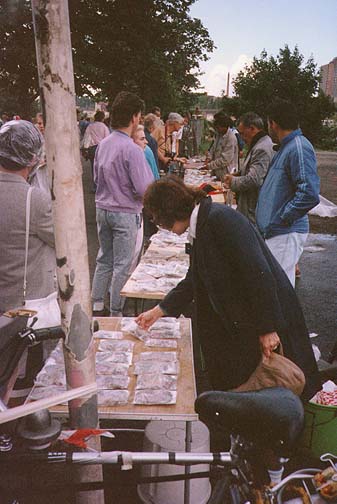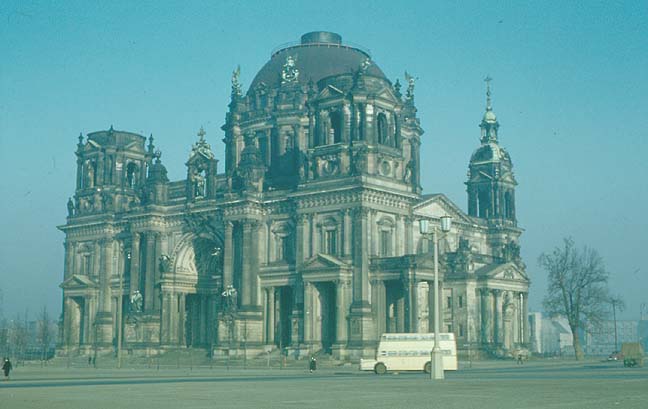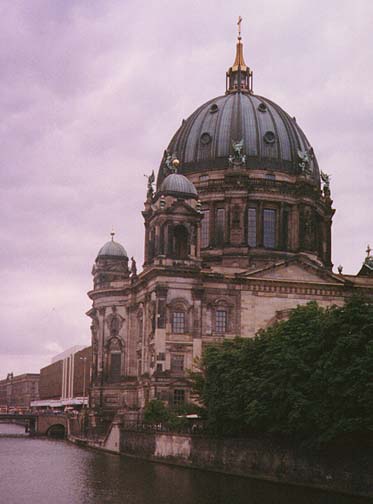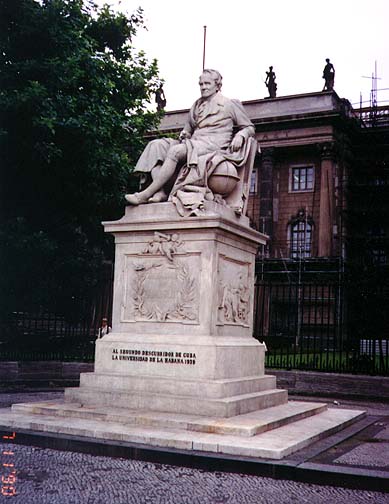

Berlin
a formerly isolated city in Europe

The WALL separating East and West

People buying pieces of the Wall.
![]()

Brandenburg
Gate
(after the Wall was removed)

before the wall in 1957
More Photos of the Brandenburg Gate
![]()

cathedral in ruins (1957)

The rebuilt Berlin Cathedral

Alexander von Humboldt
Humboldt, (Friedrich Wilhelm Heinrich) Alexander, Freiherr von (1769-1859), German naturalist and explorer, best known for his many valuable contributions to the study of geophysics, meteorology, and oceanography.
statue now protected in wooden box frame (2004)
Humboldt was born in Berlin on September 14, 1769, and educated privately and at various universities and the mining academy at Freiberg. Although he was known as a naturalist, diplomat, astronomer, mineralogist, and anatomist, his fame also rests on his exploration of Latin America. In 1799 he sailed from Spain, stopped briefly at the Canary Islands, and finally landed at Cumaná, Venezuela. Humboldt explored the entire length of the Orinoco River and most of the Amazon River system. He also traveled in Cuba, the Magdalena River basin of Colombia, and the Andes Mountains of Ecuador, where he ascended the volcano Chimborazo to an altitude of more than 5800 m (19,000 ft) above sea level. He studied ocean currents, relative temperature according to altitude, and magnetic intensity in relation to the equator, as well as minerals and plant and animal life. He spent the final period of his five-year exploration of America in Mexico. In 1804 he returned to Europe, and in 1829 he made a voyage of scientific exploration through the Ural and Altay Mountains of Russia. During the final years of his long life Humboldt wrote a five-volume work, Kosmos (The Cosmos, 1845-1862), in which he set forth not only his own vast scientific knowledge but also most of the accumulated scientific knowledge of geography and geology of the time. Kosmos has been called the first textbook of geophysics. Humboldt died in Berlin on May 6, 1859.
Charlottenburg Palace
Elector Frederick III had a summer residence built for his wife Sophie Charlotte by the architect Johann Arnold Nering between 1695 and 1699.
The Great Elector (of Prussia)
Rebuilt Church am Gendarmenmarkt
The "Trabi"
(East German car, Trabant, made largely of
recycled plastics)Photos of East Berlin, DDR, 1963
Photos of East Berlin, DDR, 1990
and let us never forget that horrible night
"Reichskristallnacht"
Berlin 1957
Reichstag still in ruins after WW II
Reichstag Fire, burning of the German parliament building in Berlin on February 27, 1933, less than a month after Nazi leader Adolf Hitler became chancellor. The fire was used as a justification for the suspension of many constitutional guarantees and also as an excuse to attack the Communists. There is still debate over whether the Nazis were involved in this crime, of which they were the main beneficiaries. Three Bulgarians and a German were all indicted and tried in Leipzig, Germany, but only a Dutch communist, Marinus van der Lubbe, was convicted.
Reichstag in the midst of the bombed out center of Berlin
Memorial to the liberating Soviet Army
(Reichstag in the background)Photos of the same locations in 2004
Bear in Tiergarden
Berlin at night
(silhouette of Wilhelm's church)
Photos from my ELDERHOSTEL Fine Arts program (Berlin 1993)
Other Countries in Europe
Albania
Andorra
Austria
Belgium
Bellorussia
Berlin
Bosnia
Bulgaria
Croatia
Cyprus
Czech Republic
Denmark
England
Estonia
Finland
France
Germany
Gibraltar
Greece
Hungary
Ireland
Isle of Man
Italy
Liechtenstein
Lithuania
Luxembourg
Macedonia
Mallorca
Malta
Monaco
Montenegro
the Netherlands
Norway
Poland
Portugal
Romania
Russia
San Marino
Sardinia
Sicily
Slovenia
Slovakia
Spain
Sweden
Switzerland
Turkey
Vatican City